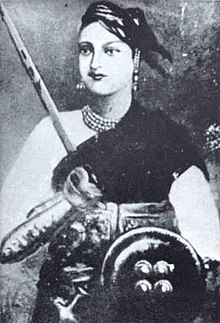Lakshmibai

Lakshmibai ( Hindi : लक्ष्मीबाई , Lakṣmībāī , originally Manikarnika मणिकर्णिका Maṇikarṇikā ; * 1828 in Benares ; † June 17, 1858 in Gwalior ) was a Rani of Jhansi and a leader of the great Indian uprising of 1857 .
Life
Mannikarnika was married to the much older Raja of Jhansi Gangadhar Rao in 1842 . She was given the name Lakshmi Bai. The connection resulted in a son in 1851, who however died shortly afterwards. Before his death on November 21, 1853, Gangadhar Rao adopted a five-year-old relative to succeed him on the throne. Lakshmi Bai was to rule for him until he came of age. According to the Doctrine of Lapse , however, Lord Dalhousie , the British Governor General of India , annexed the state after the Raja's death. The dethroned Rani was allowed to continue to reside in the palace and received a generous pension. The Rani protested against this treatment in London , but their appeal was not granted.
When the Sepoys stationed in front of Jhansi joined the great Indian uprising in June 1857, the Europeans living there placed themselves under their protection. However, the Rani could not prevent most of them from being murdered by insurgent Indian soldiers on June 8th. In the months that followed, troops from neighboring princely states invaded their territory. After her appeals for British aid were unsuccessful, she assembled an army which she led herself. She was thus victorious against the Prince of Orchha . When British troops under General Rose marched on Jhansi in March 1858 to take revenge there for the massacres of Europeans and Eurasians, she decided to defend the fortress of Jhansi at the head of the rebels. After the British took the fortress, she escaped with a small retinue. She joined other insurgents, but was defeated at Kalpi on May 22nd . Then she fought with Tantya Tope at Gwalior.
Jhansi was captured by the British on April 3rd. More than 3,000 Indians were killed. Most of the victims were unarmed civilians. The Rani von Jhansi managed to leave the city with her adopted son and fifty followers before the British could arrest them. On May 22nd, British troops attacked Kalpi fortress. The Rani von Jhansi personally led the counterattack by Indian troops. The Indian troops were also defeated in this battle. Once again, the Rani managed to escape together with other leaders of the uprising such as Tantya Tope, Banda's nawab and Rao Sahib, Nana Sahib's nephew . In Gwalior they were able to persuade the Indian troops stationed there to join the uprising. The Maharath, who remained loyal to the British, fled the district. Sir Hugh Rose and his troops had followed the fugitives. On June 16, he reached the outskirts of the city of Gwalior. On June 17th, the Rani von Jhansi was killed in a cavalry battle. According to an eyewitness report, she was wearing the uniform of a sowar and attacked one of the British riders. She was thrown from her horse herself and suffered an injury, probably from a blow by the British cavalryman with a saber. She shot her attacker with a pistol. However, this killed her with a rifle shot. It fell there on June 17, 1858, in one of the last major military conflicts of the uprising.
Lakshmibai in art
- Sohrab Modi's historical film The Maharani of Dschansi ( Jhansi Ki Rani , India 1952) deals with her biography. The title role was played by the actress Mehtab . Lakshmi Bai also appears in the film The Rising and is played by Varsha Usgaonkar .
- The novel Flashman in the great game by George MacDonald Fraser is set partly in Jhansi at the time of the great uprising and Lakshmi Bai plays a leading role in it.
- In the novel Around the Indian Imperial Crown by Robert Kraft , the biography of the "Begum", which is the focus of attention, is expanded to include elements similar to popular rumors.
Honors
Statues of her are in Agra and Ahmedabad. The following are named after her: the Laxmibai National University of Physical Education in Gwalior, the Maharani Laxmi Bai Medical College in Jhansi and the Rani Jhansi Marine National Park (in the Andamans). In addition, a women's unit in the Indian army is named after her (the Rani Jhansi Regiment). She was mentioned in songs and poems and in 1957 postage stamps were issued in her honor.
Individual evidence
literature
- David, Saul: The Indian Mutiny . Penguin, 2006
- Haythornthwaite, Philip J .: The Colonial Wars Source Book . London: Arms and Armor Press, 1995, ISBN 978-1-85409-436-0
- Jerosch, Rainer: The Rani von Jhansi - unwilling rebel: biography of the legendary Indian freedom fighter from 1857/58 . Peter Lang GmbH, Internationaler Verlag der Wissenschaft, 2003, ISBN 978-3631506486
Web links
- chronology
- Rani Lakshmibai - warrior queen ; Saints, Sisters, and Sluts (English)
- Lakshmibai, Rani of Jhansi ; Allen Copsey
| personal data | |
|---|---|
| SURNAME | Lakshmibai |
| ALTERNATIVE NAMES | Mannikarnika (original name); Lakshmi Bai; Laxmibai |
| BRIEF DESCRIPTION | Rani von Jhansi in northern India and leader of the Sepoy uprising |
| DATE OF BIRTH | 1828 |
| PLACE OF BIRTH | Benares |
| DATE OF DEATH | June 17, 1858 |
| Place of death | Gwalior |

